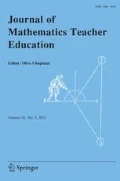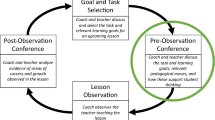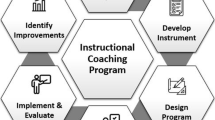Abstract
The past decade has witnessed a strong, standards-based call for improving what mathematics is taught and how it is taught. In the USA, districts have hired instructional coaches to help teachers shift their teaching from algorithm-based instruction to instruction that is more student-centered and conceptually focused. The purpose of this study was to contribute to the field’s understanding of (a) the specific coaching practices that help teachers enact more conceptual-based forms of instruction; and (b) how coaches learn to enact those practices. Using a design-based implementation research approach, we trained coaches using a particular model for one-on-one coaching (Content-Focused Coaching); the coaches then worked with teachers to plan lessons aligned with the coaching model. Data consisted of videotapes of pre-lesson conferences that were transcribed and coded according to the model. Analyses of 32 coaches’ practice over a 2-year period suggest that each of the three components of our coaching model (attention to student thinking, pedagogy, and mathematics) demonstrated statistically significant improvement over time. An illustrative analysis of five coaching sessions of one coach revealed a progression over five sessions from planning discussions that stayed at the level of general strategies to more specific conversations about teaching a particular task and then to deeper discussions that integrate attention to mathematical concepts, student thinking, and pedagogical moves. We view this delineation of coach learning as an important first step in laying the groundwork for the design of future coach training.


Similar content being viewed by others
Notes
The Institute for Learning is a professional development group within the University of Pittsburgh’s Learning Research and Development Center.
The intervention also included a post-lesson conference, but it was not the focus of this study.
Coaches varied in the number of times they co-planned and observed lessons with their partner teachers between training sessions; we asked them to select one for the videotaping.
The rubric for Advancing Questions was constructed with only three different levels purposefully. There were only two fundamental points of distinction. Rather than try to force another distinction, we decided that it would be better to leave only three levels to promote better reliability between raters.
This is noteworthy because teachers’ instructional ratings are sometimes (artificially) raised when the coach joins them during a lesson; coaches’ actions and questioning can raise the level of cognitive demand and/or help to maintain it.
The coach was not a veteran of our project.
Especially noteworthy in the previous coding of this coach was her improvement in guiding discussions of multiple solution strategies in depth; Brianna started lower than the overall mean (all strategies discussed at a very superficial level) but finished above the mean at the top-most score of “at least 2 solution strategies discussed in depth.”
Big ideas and associated essential understandings for developing thinking in various grade bands and topic areas (published by NCTM, 1989, 2000, 2014). For example, for Algebra Grades 3–5, the big ideas relate to the fundamental properties of number and operations, the use of the equals sign to represent equivalence, variables as efficient tools for representing mathematical ideas, quantitative reasoning as a way to understand mathematical relationships, and functional thinking to generalize relationships between co-varying quantities (Blanton et al., 2011).
Holding conversations about goals and how they should guide decision making before and during the lesson are part of the pre-lesson planning conference in the coaching model.
References
Australian Association of Mathematics Teachers. (2010). AAMT response to the draft K-10 Australian curriculum: mathematics. AAMT. Retrieved from https://www.aamt.edu.au/content/download/39346/562323/file/AAMT%20response%20on%20Draft1.1%20of%20NNLP_August.pdf.
Biancarosa, G., Bryk, A., & Dexter, E. R. (2010). Assessing the value-added effects of literacy collaborative professional development on student learning. Elementary School Journal, 3(1), 7–34.
Bill, V. & Speranzo, L. (2017). Coaching with intention. In Presentation at the annual meeting of the National Council of Teachers of Mathematics. San Antonio, TX.
Blanton, M., Levi, L., Crites, T., Dougherty, B., & Zbiek, R. M. (2011). Developing essential understanding of algebraic thinking for teaching mathematics in grades 3-5. Series in essential understandings. National Council of Teachers of Mathematics.
Boaler, J., & Staples, M. (2008). Creating mathematical futures through an equitable teaching approach: The case of railside school. Teachers College Record, 110, 608–645.
Campbell, P. F., & Malkus, N. N. (2011). The impact of elementary mathematics coaches on student achievement. The Elementary School Journal, 111(3), 430–454.
Clark, C. (1978–1979). A new question for research on teaching. Educational Research Quarterly, 3, 53–58.
Coburn, C. E., & Russell, J. L. (2008). District policy and teachers’ social networks. Education Evaluation and Policy Analysis, 30(3), 203–235.
Cohen, D. K., Raudenbush, S., & Ball, D. (2003). Resources, instruction, and research. Educational Evaluation and Policy Analysis, 25(2), 1–24.
Fernandez, C., & Yoshida, M. (2004). Lesson study: A Japanese approach to improving mathematics teaching and learning. Lawrence Erlbaum.
Gallucci, C., Van Lare, M. D., Yoon, I. H., & Boatright, B. (2010). Instructional coaching: Building theory about the role and organizational support for professional learning. American Educational Research Journal, 47(4), 919–963.
Gibbons, L. K., & Cobb, P. (2016). Content-focused coaching practices implicated in designing potentially productive coaching activities to support teachers’ learning. Elementary School Journal, 117(2), 237–260.
Hiebert, J., & Grouws, D. A. (2007). The effects of classroom mathematics teaching on students’ learning. In F. K. Lester (Ed.), Second handbook of research on mathematics teaching and learning (pp. 371–404). Information Age Publishing.
Hiebert, J., Stigler, J. W., & Manaster, A. B. (1999). Mathematical features of lessons in the TIMSS Video Study. ZDM, 31(6), 196–201.
Hiebert, J., Morris, A. K., & Spitzer, S. M. (2018). Diagnosing learning goals: An often overlooked teaching competency. In T. Leuders, K. Phillip, & J. Leuders (Eds.), Diagnostic competence of mathematics teachers: Unpacking a complex construct in teacher education and teacher practice (pp. 193–206). Springer.
Horn, I. S., & Little, J. W. (2010). Attending to problems of practice: Routines and resources for professional learning in teachers’ workplace interactions. American Educational Research Journal, 47(1), 181–217.
Huinker, D., & Bill, V. (2017). Taking action: Implementing effective mathematics teaching practices in K-grade 5. Reston, VA: National Council of Teachers of Mathematics.
Hunt, J., & Stein, M. K. (2017). Coaching and mathematical goal setting. In Paper presented at the annual research conference of the National Council of Teachers of Mathematics. San Antonio, TX.
Kagan, D., & Tippins, D. (1992). The evolution of functional lessons among twelve elementary and secondary student teachers. Elementary School Journal, 92, 477–489.
Kazemi, E., & Hintz, A. (2014). Intentional talk: How to structure and lead productive mathematical discussions. Stenhouse.
Killion, J. (2009). Coaches’ roles, responsibilities, and reach. In J. Knight (Ed.), Coaching: Approaches & perspectives (pp. 7–28). Corwin Press.
Lampert, M. (2001). Teaching problems and the problems of teaching. Yale University Press.
Lewis, C. (2002). Lesson study: A handbook of teacher-led instructional change. Research for Better Schools.
Little, J. W. (2003). Inside teacher community: Representations of classroom practice. Teachers College Record, 105(6), 913–945.
Little, J. W., & Horn, I. S. (2007). “Normalizing” problems of practice: Converting routine conversation into a resource for learning in professional communities. In L. Stoll & K. S. Louis (Eds.), Professional learning communities: Divergence, detail and difficulties (pp. 79–92). Open University Press.
Matsumura, L. C., Garnier, H. E., & Resnick, L. B. (2010). Implementing literacy coaching: The role of school social resources. Educational Evaluation and Policy Analysis, 32(2), 249–272.
Matsumara, L. C., Garnier, H. E., & Spybrook, J. (2012). The effect of content-focused coaching on the quality of classroom text discussions. Journal of Teacher Education, 63(3), 214–228. https://doi.org/10.1177/0022487111434985
National Centre for Excellence in the Teaching of Mathematics (UK). (2008). Mathematics matters: final report. Retrieved from https://www.ncetm.org.uk/public/files/309231/Mathematics+Matters+Final+Report.pdf.
National Council of Teachers of Mathematics. (2014). Principles to actions: Ensuring mathematical success for all. NCTM.
National Governors Association Center for Best Practices & Council of Chief State School Officers. (2010). Common core state standards for mathematics. NGA Center & CCSSO. Retrieved from http://www.corestandards.org/assets/CCSSI_Math%20Standards.pdf.
National Council of Teachers of Mathematics. (1989). Curriculum and Evaluation Standards for School Mathematics. NCTM.
National Council of Teachers of Mathematics. (2000). Principles and Standards for School Mathematics. NCTM.
Neergaard, L., Smith, T., Hochberg, E., & Desimone, L. (2011, September). Impact of organizational supports for math instruction on the instructional quality of beginning teachers. Paper presented at the annual conference of the Society for Research on Educational Effectiveness, Washington, DC.
Penuel, W. R., Fishman, B. J., Haugan Cheng, B., & Sabelli, N. (2011). Organizing research and development at the intersection of learning, implementation, and design. Educational researcher, 40(7), 331–337.
Resnick, L. B., Asterhan, C. S. C., & Clarke, S. N. (Eds.). (2015). Socializing intelligence through academic talk and dialogue. American Educational Research Association.
Russell, J. L., Correnti, R., Stein, M. K., Thomas, A., Bill, V., & Speranzo, L. (2020). Mathematics coaching for conceptual understanding: Promising evidence regarding the tennessee math coaching model. Educational Evaluation and Policy Analysis, 42(3), 439–466. https://doi.org/10.3102/0162373720940699
Russell, J. L., Jackson, K., Krumm, A. E., & Frank, K. A. (2013). Theories and research methodologies for design-based implementation research: Examples from four cases. National Society for the Study of Education Yearbook, 112(2), 157–191.
Sailors, M., & Price, L. R. (2010). Professional development that supports the teaching of cognitive reading strategy instruction. The Elementary School Journal, 110(3), 301–322.
Smith, J. P., III. (1996). Efficacy and teaching mathematics by telling: A challenge for reform. Journal for Research in Mathematics Education, 27, 387–402.
Smith, M., & Stein, M. K. (2018). Five practices for orchestrating productive mathematics discussions (2nd ed.). Thousand Oaks, CA: Corwin Press.
Smith, M. S., Bill, V., & Hughes, E. K. (2007). Thinking through a lesson: The key to successfully implementing high level tasks. Mathematics Teaching in the Middle School, 14(3), 1–17.
Smith, M. M., & Sherin, M. (2019). The five practices in practice. Corwin.
Spillane, J. P. (1999). External reform initiatives and teachers’ efforts to reconstruct their practice: The mediating role of teachers’ zones of enactment. Journal of Curriculum Studies, 31(2), 143–175.
Stein, M.K. & Bill, V. (2016). An instructional mathematics coaching model: A means to deep and specific conversations. In Presentation at the annual meeting of the Association of Mathematics Teacher Educators. Irvine, CA.
Stein, M. K., Engle, R. A., Smith, M. S., & Hughes, E. K. (2008). Orchestrating productive mathematical discussions: Five practices for helping teachers move beyond show and tell. Mathematical Thinking and Learning, An International Journal, 10(4), 313–340.
Stein, M. K., Grover, B. W., & Henningsen, M. (1996). Building student capacity for mathematical thinking and reasoning: An analysis of mathematical tasks used in reform classrooms. American Educational Research Journal, 33(2), 455–488.
Stein, M. K., & Lane, S. (1996). Instructional tasks and the development of student capacity to think and reason: An analysis of the relationship between teaching and learning in a reform mathematics project. Educational Research and Evaluation, 2, 50–80.
Stein, M. K., & Meikle, E. (2017). The nature and role of goals in mathematics education. In D. Spangler & J. Wanko (Eds.), Research companion to principles to actions (pp. 1–11). National Council of Teachers of Mathematics.
Thompson, C. L., & Zeuli, J. S. (1999). The frame and the tapestry: Standards-based reform and professional development. In L. Darling Hammond & G. Sykes (Eds.), Teaching as the learning profession: Handbook of policy and practice (pp. 341–375). Jossey Bass.
Zahorik, J. A. (1975). Teachers’ planning models. Educational Leadership, 33, 134–139.
Funding
The research reported herein was supported by the James S. McDonnell Foundation - Understanding Teacher Change and Teachers as Learners in K-12 Classrooms - grant https://urldefense.proofpoint.com/v2/url?u=https-3A__doi.org_10.37717_220020525&d=DwIGaQ&c=vh6FgFnduejNhPPD0fl_yRaSfZy8CWbWnIf4XJhSqx8&r=tr37p-LMKuZcfSC3Gl2yDqo9ZcrJey8lTPYOKaBGIF6yshihKd8RA64oNKKOSEMe&m=w3lZftmD0AgykIJE_VbRuxvkLM1BD7RKyiDUP0sfRk0&s=bK2LiDIcJf4y5xNLhWVnIvV0_uO5dWU861jOABq_o8k&e= and by the Institute of Education Sciences, U.S. Department of Education, through Grant R305H140112 to University of Pittsburgh. The opinions expressed are those of the authors and do not represent views of the foundation or the Institute or the U.S. Department of Education.
Author information
Authors and Affiliations
Corresponding author
Additional information
Publisher's Note
Springer Nature remains neutral with regard to jurisdictional claims in published maps and institutional affiliations.
Rights and permissions
About this article
Cite this article
Stein, M.K., Russell, J.L., Bill, V. et al. Coach learning to help teachers learn to enact conceptually rich, student-focused mathematics lessons. J Math Teacher Educ 25, 321–346 (2022). https://doi.org/10.1007/s10857-021-09492-6
Accepted:
Published:
Issue Date:
DOI: https://doi.org/10.1007/s10857-021-09492-6




